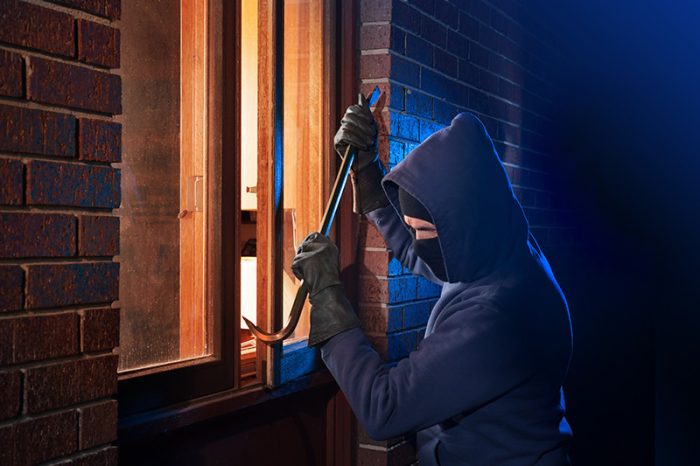Have you ever said or overheard someone say while in a public place, “The kids gave me a TV for my birthday,” or “I just got a great deal on a laptop computer?” Do you hide a house key under the back-door mat or leave your doors unlocked during the day? If so, you are leaving yourself open to being victimized.
It’s important for all homeowners to take precautionary measures, but more so for older adults. Robbers are a threat to physical well-being, as well as personal goods. Being physically attacked can result in long months of rehabilitation.
So, keeping within the bounds of common sense, let the evidence be a call to action, not just another reason to worry. Before paranoia sets in, first consider that there are measures you can take to thwart the possibility of a home burglary.
Short of installing electrified fencing guarded by watchdogs and high-tech video cameras monitored by security staff (which, by the way, sends a message that there are valuables to be had), what common sense, practical precautions and safety measures should a call to action initiate? These are the obvious ones:
- Don’t hide a key outdoors. Ask a trusted neighbor or nearby loved one to keep an extra house key on hand in case it’s needed.
- Install a security alarm and outdoor lighting and keep them maintained.
- Lock doors and windows when they don’t need to be opened.
- Properly install deadbolts on all outside doors. It’s very easy to “card” and open a button lock so having a deadbolt lock is critical.
- Keep the garage door closed; the contents could be tempting. If there is an electric door opener consider adding a deadbolt to foil a thief that might have captured the code.
- Keep bushes and shrubs around the house trimmed so they cannot shield a burglar from view.
- Don’t advertise your TV or computers. In other words, if they can be seen from the street or first floor window, they could tempt a potential burglar.
- Don’t discard boxes or packaging of high-priced electronics, etc., at your premises unless they are broken down and no longer identify the original contents. They are a sign valuables are inside the home.
- Carefully screen service personnel invited into your home for maintenance of furnaces, plumbing, etc. Check their identity. Don’t leave valuables and important papers in visible places during their visit.
- Report any suspicious activity in the neighborhood to law enforcement.
Burglars avoid homes that appear to be occupied so make it appear that someone is at home.
- Check your mailbox daily. Remove advertising flyers or packages left at the front door.
- Leave a radio or television on during the day and early evening. Leaving a radio or television on during the day and early evening will signal occupancy no matter where the vehicle is parked.
- Leave a vehicle in the driveway (or, keep it in the garage).
- Depending on the season, have your front walk cleared of leaves/snow/ice, keep the lawn mowed and the bushes trimmed.
If you should plan to go on a trip, don’t advertise your absence; your plans could change. Some precautions to keep in mind:
- Rather than request the Post Office hold your mail, have someone collect the mail daily. Consider that regular mail delivery indicates someone is at home.
- Have someone check the house regularly to remove “door hanger” advertising or other notices.
- Ask a neighbor to put some of their trash at your curb/or into your bin, so it appears you are at home.
- Never post your trip plans on social media, such as Facebook. Don’t discuss trip details in public places.
- Set any house lights, radios, televisions on timers. A well-lit house with a TV blaring at 2am probably won’t fool a burglar.
- If you need a lift to the airport/train station/etc. have the driver pick you up somewhere near your home so your address is unknown. That information could be used against you.
Contact the local law enforcement agency to learn what precautionary measures they suggest taking to protect against home burglaries. Some police departments have programs and/or tips addressing crime prevention for Seniors.
It is important to take these precautions a step further. You can sit down with family members to address the possibility that a home robbery with injuries could occur. It makes good sense to have a written emergency plan prominently displayed in the home as a reference for first responders. The plan should include emergency contacts and pertinent medical information.
- You and your family members should develop, carry, and post an “Emergency Tree” listing. First responders can quickly find information on which family member to call. Once contacted, that person can alert the next person in the tree. (Each person on the list will contact the next following so all will be informed of the emergency in a logical manner.)
- Also important is posting an up-to-date document listing doctors, medications and any other pertinent details that should be made known to first responders.
- If you use a medical alert device, information regarding the system should also be prominently posted.
Finally, take the time to research, review and establish a workable “Precautionary Measures Plan” that suits your home situation. Make it a family project so all involved are familiar with the options and the choices. People whose families are on board will benefit from having a pooled knowledge base and a shared ownership of the plan. More eyes and hands make it easier to execute the plan and maintain its effectiveness.
It’s unfortunate that incidents of older adults being victimized in home burglaries will continue. This fact is a red flag not to be ignored. Creating a plan is important so you can relax knowing there are steps that can be taken.

